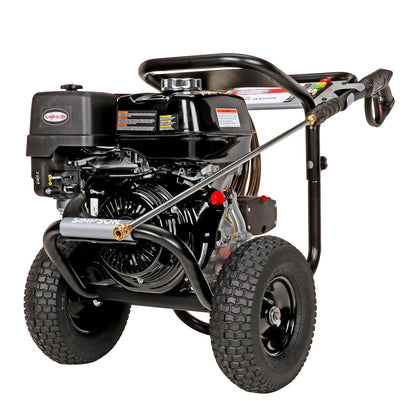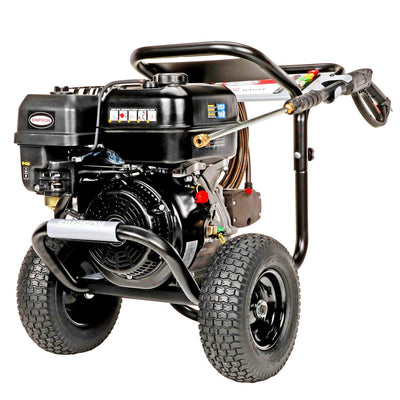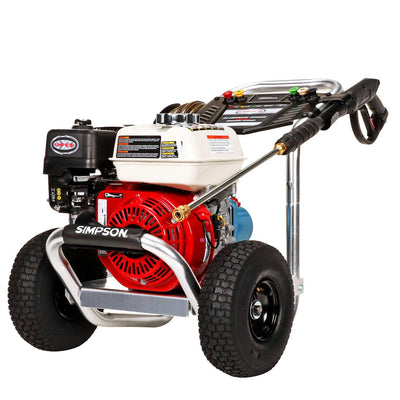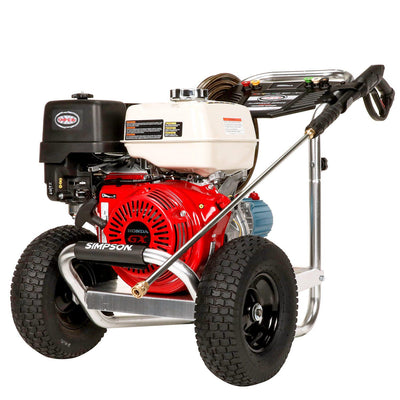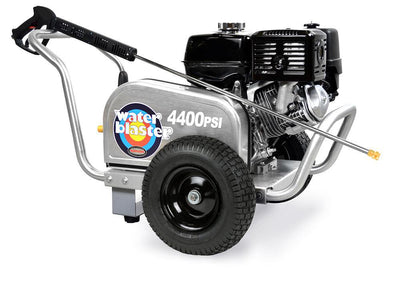The Ultimate Pressure Washer Buying Guide
Pressure washers are the perfect tool for cleaning, prepping surfaces for paint, and much more. The number of pressure washers available are staggering with many different PSI, GPM, Pump, and Engine options available. With so many choices it can be challenging to determine the best pressure washer for your budget and project needs. In this guide we will cover the 6 different aspects to consider to ensure you choose the ideal pressure washer for you. The six different choices include the pump type, the PSI of the pressure washer, the GPM output of the pressure washer, whether you want a Hot or Cold Washer, power source (electric or gas), and drive type of the pressure washer. By considering and understanding these 6 elements you will be able to get a pressure washer that will work and last well for your project needs.
Step 1 – Choose the Ideal Pressure for Your Pressure Washing Needs
The Pressure (PSI) of your Pressure Washer will be one of two key choices to consider to ensure you pick a power washer with enough strength to effectively clean the surfaces you want. The chart below shows what pressure is ideal for cleaning a variety of different surfaces, you should choose enough pressure to clean the most difficult surface you plan on being able to tackle with your pressure washer.
|
Items to clean |
1500 |
2500 |
3000 |
4000 |
|
Grills, Chairs |
X |
X |
X |
x |
|
Bikes, Kids Metal Toys |
X |
X |
X |
X |
|
Vehicles |
X |
X |
X |
X |
|
Decks, Docks, Wood Surfaces |
|
X |
X |
X |
|
Boats, Jet Skis |
|
|
X |
X |
|
Home Siding |
|
|
X |
X |
|
Asphalt |
|
|
X |
X |
|
Industrial Equipment/ Construction Equipment |
|
|
X |
X |
|
Paint Removal |
|
|
|
X |
|
|
|
|
|
|
Step 2 – Choose the Right GPM for Your Pressure Washer
The GPM output of your Pressure Washer will matter for two reasons. The GPM along with the PSI of your Pressure Washer will determine how fast you can clean a given surface and the GPM of your pressure washer will impact the type and size of surface cleaner you can use with your Pressure Washer.
To be able to use a surface cleaner it is usually ideal to have 4 GPM of output from your washer. To understand how more GPM can impact cleaning speed you can check out the chart below which estimates how long two pressure washers will take to clean a surface if they have the same PSI but a different GPM output. To understand a bit more on GPM and its impact on cleaning speed you can refer to our complete guide here.
|
Cleaning Time* |
2 GPM |
2.5 GPM |
3 GPM |
3.5 GPM |
4 GPM |
|
20 min |
|||||
|
18 min |
|||||
|
16 min |
|||||
|
14 min |
x |
||||
|
12 min |
|||||
|
10 min |
x |
||||
|
8 min |
x |
||||
|
6 min |
x |
||||
|
4 min |
x |
||||
|
2 min |
*Times shown are for comparison use only. Actual times will depend on operator skills and condition and size of job application.
.
Step 3 – Consider and Match the Ideal Pump Type for Your Pressure Washing Needs
After you have decided what PSI and GPM will be required in order to effectively clean the surfaces you want, the next consideration to think about is the type of pump that will be best for your pressure washer. There are 3 primary pump types that are available for a pressure washer axial, triplex, and wobble style pumps. Triplex pumps tend to outlast an Axial pumps and Axial pumps tend to outlast Wobble pumps. For a complete overview of pressure washer pump types showing how each function and more check out this guide.
In addition to the pump type, it is best to consider the type of unloader valve you want on your pressure washer. An unloader allows you not to have pressure at the gun handle when you release the trigger. Unloaders can be bolted on after the pump or built into the pump. An external bolt on unloader allows for easier repair if the unloader wears out (which can be important as unloaders are one of the most common items to fail on a pressure washer). External unloaders are also often available in an adjustable design which allows you to reduce the pressure of the washer, which can be handy when you want a pressure washer to clean anything from concrete to decks. An internal unloader is usually less expensive than an external unloader but can be difficult to repair if an issue arises and is not adjustable.
For more on the pump types and unloaders check out our guide here.
Step 4 – Hot Water or Cold Water Pressure Washer which One To Choose
After knowing the pressure, GPM, and Pump Type You want to choose for your Pressure washer you should consider if you want the pressure washer to only work with cold water or if you also need hot water from your pressure washer.
The majority of customers will only need a cold water pressure washer. However, for cleaning off oil and grease or for faster cleaning speed, a hot water washer will provide better results.
A hot water pressure washer will end up costing more than a cold water pressure washer because of the additional components like a heating coil.
Step 5 – Determine the Best Drive Type for Your Pressure Washer
There are 3 primary ways your pressure washer’s engine and pump will connect to each other. The washer can be directly connected, connected via a belt, or connected via gears.
A belt drive will operate at the lowest rpm and will minimize the wear the pump experiences. A belt drive pressure washer will cost more than a direct drive. However, it will outlast gear or direct drive pressure washers. Additionally if the engine or pump ever freeze up you usually don’t end up ruining the pump and the engine as they are not directly tied together.
Gear Drive Pressure washers are also a good pressure washer option for higher volume use, generally they are not quite as ideal as a belt drive pressure washer for longevity, but they do tend to outlast direct drive pressure washers.
Finally you have a direct drive pressure washer, with a direct drive pressure washer the engine and pump are directly connected. This provides the most economical setup for a pressure washer but results in less longevity compared to a belt or gear drive setup.
Step 6 – Decide how you want your power washer to be Powered (Electric or Gas Powered)
Electric pressure washers are available at some of the lowest prices for light use models but for a pressure washer with a high PSI and GPM requirement an electric washer will be more expensive. Electric pressure washers are also best for indoor pressure washing needs. So if you are on a limited budget and looking for something affordable for light cleaning an electric pressure washer can be a great choice, or if require to use the pressure washer indoors, then electric is ideal.
Gas pressure washers are ideal for those who want portability and/or are looking for higher psi and GPM performance at lower prices.
Overall by considering the PSI, GPM, Pump Type, Water Type, Power Source, and type of drive configuration for your pressure washer you can ensure you choose a pressure washer that will be ideal for your project and frequency requirements.



